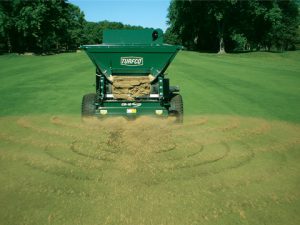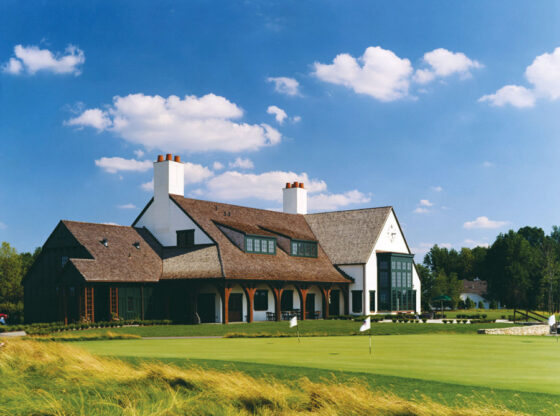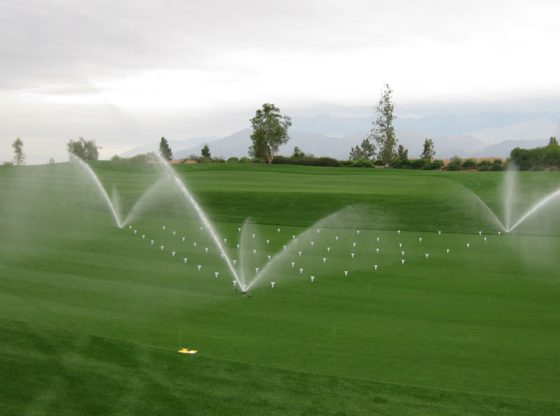The practice of topdressing greens, whether it’s a heavy sanding done during aerification or a light topdressing applied biweekly in-season, is something nearly every golf course superintendent per-forms at some level.
Topdressing is mainly used for smoothing the greens, but also helps in preventing excessive thatch buildup. Other benefits include: promoting upright growth, better water absorption, and modifying and building a healthy soil profile. In addition to smoothing the greens’ surfaces, topdressing creates a more consistent putting experience from green to green.
There are many tips to consider when creating a topdressing program. Whether it be heavy aerification topdressing or your frequent light topdressing in-season, here are nine tips to consider.
1. Beware of Stress
Topdressing is a method that can be part of a program to relieve stress situations on grass. However, topdressing can also add stress to already-stressed greens if done when those greens are already suffering. This can be tricky so make sure the greens are healthy enough to handle a sanding and brushing. Excessively dry greens, greens suffering from heat stress, and greens infested or recovering from disease aren’t fit to be topdressed. Wait until you get them healthy enough to handle this cultural practice.
2. Use Quality Sand
 All sands are not created equal. Some bargain sands may be tempting to buy, but down the road will cost you more money. Having to rebuild your greens down the road because of the insufficient sand will cost you. Make sure you’re in the right sand percentage range of 80 to 95 percent. Your particle range must also be between .15 to .75 millimeter in size. Typically if you have been using a sand for a long time and it works, don’t switch. You are typically safer because changes can cause layering, which causes problems.
All sands are not created equal. Some bargain sands may be tempting to buy, but down the road will cost you more money. Having to rebuild your greens down the road because of the insufficient sand will cost you. Make sure you’re in the right sand percentage range of 80 to 95 percent. Your particle range must also be between .15 to .75 millimeter in size. Typically if you have been using a sand for a long time and it works, don’t switch. You are typically safer because changes can cause layering, which causes problems.
3. Don’t Over-Brush
After a light topdressing, brushing the sand into the canopy should only be done once. This means you should only pass over it once. The point is not to make the sand disappear. Rain and other factors will work the sand into the canopy. Avoid going over it multiple times especially when applying a light topdressing.
4. Have Some “Rock Crushers” Ready
Mowing sand is rough on reels and bedknives. It is best to have a mower or two set aside to act as “rock crushers.” These rock crushers can be used for the first mowing of the greens after a topdressing, either the same day or the next morning. Doing so will prevent further damage to your equipment and will get the job done.
5. Timing Matters
Make sure to check the course schedule before topdressing. Topdressing the morning of a big tournament, or the day your boss is coming out to play is probably not a good idea. Although topdressing will improve play-ability and smooth out greens, this result doesn’t occur the same day of the topdressing. Like they say, Rome wasn’t built in a day. Plan out your topdressing for a prime time for results.
6. Create a Window
Create enough time to properly topdress the turf. If you don’t create a big enough window for yourself, the maintenance may not get completed in time or in a proper way. Communicate with the pro shop why you need to topdress and the window that needs to be created to get the job done. Where the pro shop follows revenue based timing, as superintendents, we are concerned about the condition of the course. Convey a bigger picture: topdressing greens is a practice that, in the long run, will improve the golf course and create long-term revenue.
7. Check out Your Neighbors
 A good practice for any superintendent is to see what your peers are doing in the area of topdressing. Making connections within your field and industry will allow you to become more proficient in all of your operations. Keep and eye open for new techniques that can increase the quality of your course.
A good practice for any superintendent is to see what your peers are doing in the area of topdressing. Making connections within your field and industry will allow you to become more proficient in all of your operations. Keep and eye open for new techniques that can increase the quality of your course.
No one knows or understands the troubles and situations you face like other superintendents. Even just playing a round of golf on a neighboring course right after it has been aerified can be enlightening.
9. Match Your Growth
A goal with a frequent light topdressing program is to keep the thatch layer from building up. By adjusting the amount of sand you are applying to the specific growth of the turf throughout the year, you will be more successful in keeping the thatch to manageable level.
Your rate of sand may be different in the late spring than the midsummer. In addition, your rate in late summer or early fall differ from that of the midsummer. Consider all the elements that are at play. Paying attention to growth yield and clippings, as well as keeping in mind your current height of cut, are all factors you could consider to optimize your topdressing applications.
Even if you are not noticing any issues with your soil, you want to make sure there are no problems. Once or twice a year take intact soil cores and send them into the lab you use for testing. Do this especially if you are a newer superintendent at an older course.The lab will test each layer. For further information on those tests, you can read Simplifying Soil Test Interpretations for Turf Professionals.
Final Thoughts
Topdressing is not something you try once or twice and then abandon, hoping your efforts paid off. Topdressing is an integral part of a continuous effort. You are making an investment into the future of your course. No one can argue the benefits of topdressing greens. From the smoothing of the surface to thatch control to creating better water absorption, it is a practice vital to the modern day golf course superintendent.













Thanks to the excellent guide